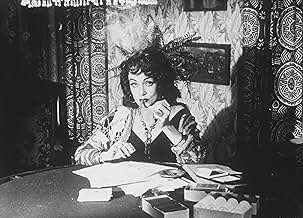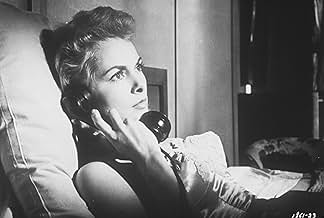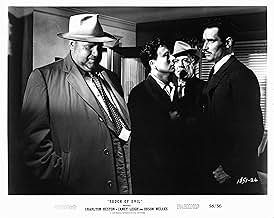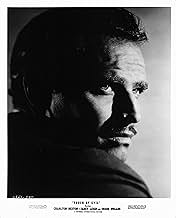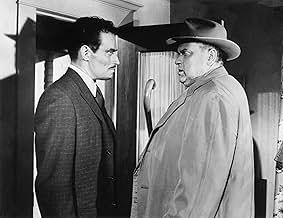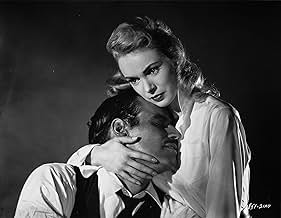Una perversa historia de asesinato, secuestro y corrupción policial en una ciudad mexicana fronteriza.Una perversa historia de asesinato, secuestro y corrupción policial en una ciudad mexicana fronteriza.Una perversa historia de asesinato, secuestro y corrupción policial en una ciudad mexicana fronteriza.
- Dirección
- Guionistas
- Elenco
- Premios
- 7 premios ganados y 1 nominación en total
Valentin de Vargas
- Pancho
- (as Valentin De Vargas)
Opiniones destacadas
Here is a film that wouldn't be made today because nobody makes 'B' movies anymore; and this is the greatest 'B' movie in the history of cinema. Here is the perfect example of why Orson Welles should be considered a genius. He has made this film look so effortlessly easy that it could almost be considered film making by numbers. From the famous opening sequence to the closing titles, this is the film students' reference book.
Welles portrayal of the bloated cop Hank Quinlan is only bettered by his Harry Lime in 'The Third Man'. He gets right inside the seedy, corrupt Quinlan; but still leaves room for just the lightest touch sympathy because we know that, after all, he's a fallible human like all of us. We almost feel sad at his fate especially when Marlene Dietrich gives her sad soliliquay about him.
This is another film that can only exist in black and white, and begs the question, why can't directors work effectively in this medium today? Some have tried but none have have really suceeded. David Lynch's Eraserhead is probably the best modern example of a black and white only film. Woody Allen's Manhattan tries hard but ends up looking too much like a documentary. I don't think that directors today use this medium enough, too many rely on colour and the efffects that can only work in colour to get them out of trouble.
So put A Touch Of Evil on your 'must see' list and enjoy a work of film making artistry.
Welles portrayal of the bloated cop Hank Quinlan is only bettered by his Harry Lime in 'The Third Man'. He gets right inside the seedy, corrupt Quinlan; but still leaves room for just the lightest touch sympathy because we know that, after all, he's a fallible human like all of us. We almost feel sad at his fate especially when Marlene Dietrich gives her sad soliliquay about him.
This is another film that can only exist in black and white, and begs the question, why can't directors work effectively in this medium today? Some have tried but none have have really suceeded. David Lynch's Eraserhead is probably the best modern example of a black and white only film. Woody Allen's Manhattan tries hard but ends up looking too much like a documentary. I don't think that directors today use this medium enough, too many rely on colour and the efffects that can only work in colour to get them out of trouble.
So put A Touch Of Evil on your 'must see' list and enjoy a work of film making artistry.
10Dr.Teeth
There are only two ways to write a review that would truly do this film justice. Either one would have to write an exceedingly long review, or a short, concise one. I choose to do the latter.
When I first saw "Touch of Evil," I was glued to the chair. When I found out it was not Welles' definitive vision, I wondered how on earth it could have been made better. And when I saw the re-released version, I wondered why the studio altered it. The stunning black-and-white images, the intricate plot, and the powerful, engaging performances took a hold of my imagination. At times, I imagined myself on the street with the characters, because the atmosphere was so thick I felt surrounded in it.
The actors all did an outstanding job, especially Leigh and Heston (who, although not thoroughly convincing as a Mexican, soared above his usual powerful, furious presence). This is Welles' picture, however, and whenever the camera catches his obese figure, you are fully aware of the man as a director and an actor. His powerful vision drives the film, from the single-cut opening sequence to the cat-and-mouse finale.
I suggest watching the 1998 restored version over the original theatrical release, but regardless of which version, "Touch of Evil" will have you stuck in your seat, questioning your views of morality until long after the last credit has rolled up the screen.
When I first saw "Touch of Evil," I was glued to the chair. When I found out it was not Welles' definitive vision, I wondered how on earth it could have been made better. And when I saw the re-released version, I wondered why the studio altered it. The stunning black-and-white images, the intricate plot, and the powerful, engaging performances took a hold of my imagination. At times, I imagined myself on the street with the characters, because the atmosphere was so thick I felt surrounded in it.
The actors all did an outstanding job, especially Leigh and Heston (who, although not thoroughly convincing as a Mexican, soared above his usual powerful, furious presence). This is Welles' picture, however, and whenever the camera catches his obese figure, you are fully aware of the man as a director and an actor. His powerful vision drives the film, from the single-cut opening sequence to the cat-and-mouse finale.
I suggest watching the 1998 restored version over the original theatrical release, but regardless of which version, "Touch of Evil" will have you stuck in your seat, questioning your views of morality until long after the last credit has rolled up the screen.
Seldom have I seen so many comments with so little understanding. The movie is not about Heston's "Mexican-ness" or lack of it. The movie is not about the 5 or 8 or 10 minute opening shot. The movie is not even, god help us, about Welles' descent from the heights into "slumming it" in a "Grade B" flick.
The movie is about two things : film-making, and character. Every shot worth remembering (and there are few that aren't) is an exercise in the possibilities of film, particularly black and white film. Woody Allen makes movies in black and white that are all conversation. Welles made movies in black and white because that's where the colors of the characters, the location and ultimately the meaning of the movie are possible. Black and white film is about the infinite possibilities of shadow. Touch of Evil is about the infinite possibilities of human nature.
Heston, for those of you who just can't see past a "bad" accent is about rigidity and short-sightedness. What kind of idiot would leave his wife in all those threatening situations? The kind of idiot who can't imagine that anyone would harm HIS wife, simply because she IS his wife! Akim Tamiroff's Grandi is about flexibility to the point of breakage. Always playing ALL ends against the middle he is the essence of "harmless" corruption, that ultimately harms everyone.
And Welles' Hank Quinlan ... I just don't have the time or space to explain that Quinlan is about the true cost of police work when the humanity has gone out of it. Ultimately Quinlan would kill his best and only friend, the only one, as Dietrich has it, who really loves him. At one time, perhaps, Quinlan WAS the image that Pete Menzies saw. But the man behind that image was eaten up long ago with alcohol and frustrated grief. It's all about winning and losing now, and things he would never do. Until he does them.
There are so many other moments and characters that I'm afraid you'll just have to watch the film with your eyes and your mind open instead of shut to "get it". Pay attention to what's on the screen instead of the smart, cynical, hip comments you can make about an actual work of heart.
Well, what the hell. Joan Didion said it best. Film criticism is petit point on kleenex.
Raoul Duke
The movie is about two things : film-making, and character. Every shot worth remembering (and there are few that aren't) is an exercise in the possibilities of film, particularly black and white film. Woody Allen makes movies in black and white that are all conversation. Welles made movies in black and white because that's where the colors of the characters, the location and ultimately the meaning of the movie are possible. Black and white film is about the infinite possibilities of shadow. Touch of Evil is about the infinite possibilities of human nature.
Heston, for those of you who just can't see past a "bad" accent is about rigidity and short-sightedness. What kind of idiot would leave his wife in all those threatening situations? The kind of idiot who can't imagine that anyone would harm HIS wife, simply because she IS his wife! Akim Tamiroff's Grandi is about flexibility to the point of breakage. Always playing ALL ends against the middle he is the essence of "harmless" corruption, that ultimately harms everyone.
And Welles' Hank Quinlan ... I just don't have the time or space to explain that Quinlan is about the true cost of police work when the humanity has gone out of it. Ultimately Quinlan would kill his best and only friend, the only one, as Dietrich has it, who really loves him. At one time, perhaps, Quinlan WAS the image that Pete Menzies saw. But the man behind that image was eaten up long ago with alcohol and frustrated grief. It's all about winning and losing now, and things he would never do. Until he does them.
There are so many other moments and characters that I'm afraid you'll just have to watch the film with your eyes and your mind open instead of shut to "get it". Pay attention to what's on the screen instead of the smart, cynical, hip comments you can make about an actual work of heart.
Well, what the hell. Joan Didion said it best. Film criticism is petit point on kleenex.
Raoul Duke
We start with a man putting a bomb in a car on the Mexican side of the border. When it explodes on the American side flattening the occupants, the local "Capt. Quinlan" (Orson Welles) decides to make a bit of a cursory investigation - in cahoots with his opposite number "Vargas" (Charlton Heston). Whilst they are out doing their sleuthing, "Susan Vargas" (Janet Leigh) is lured to a meeting with "Uncle Joe" (Akim Tamiroff) where it becomes clear that her husband is on the prosecuting side of a family dispute that is putting everyone in danger - something her husband finds out shortly afterwards when he narrowly avoids an acid facial. Now "Quinlan" and his sidekick "Menzies" (Joseph Calleia) have a rather unique way of working - the former intimidates just with his presence and has the District Attorney in his pocket, but as this investigation starts to spread out the original crime pails into insignificance as "Susan" finds herself trapped in an out of town motel and the potential victim of a ghastly drug crime that brings the threads of the story - and the true criminality to light - fatally. There are five principal characters and the actors do justice to them all - the story moves along darkly offering plenty of interest, the odd red herring and a particularly strong effort from Welles as the increasingly unlikeable policeman. I was slightly dubious about Heston playing a Mexican policeman, but here carries of the role in one of his better screen performances (when he is not wearing leather garments) and Janet Leigh - well, she was always an actor who made it all look effortless. The ending combines the scary with the brutal but will the truth be out? Big screen must for the full potency of the last twenty minutes.
Considered by many to be the last "classic" noir film ever made, and perhaps the last masterwork from child prodigy Orson Welles, who looks about sixty in this film, despite his 42 years. In TOUCH OF EVIL the "noirish" dark streets and shadows are darker than ever, practically swallowing up the soft tones like a murky swamp. The action takes place in a nondescript U.S./Mexico border town where the worst that both sides has to offer is most in evidence. The famous opening scene (a 3 1/2-minute continuous shot) where we witness a time bomb being placed in the trunk of a Cadillac is masterful. The camera pulls in and out of the city scene as it follows the motion of the vehicle winding its way through streets littered with pedestrians, thus effectively creating a level of anxiety that could not be duplicated with multiple edits. After the inevitable explosion, the drama dives into a seedy world of corrupt police justice and malevolent decrepitude, which is filmed with such a stylish flair, it is almost weirdly humorous and playful! Mike Vargas, the good guy, is played by Charlton Heston and seems more than a wee bit miscast as a Mexican narcotics officer with his face darkened by makeup. When U.S. Police Captain Hank Quinlan (Orson Welles) first meets him he remarks, "He doesn't look Mexican." Quinlan is the ultimate repugnant cop gone bad and Welles has the camera looking up into his nostrils most of the time making his character look even more monstrous. But Quinlan is also pitifully sad. A man who once had the instincts of a cat and the intelligence of a fox has been reduced to an insignificant mass of tissue, who's "instinct" is having a knack for finding evidence that he himself has planted. And while he may be revered by the local officials in law enforcement, he's acutely aware that he is a fraud and petrified that Vargas, has seen him naked.
¿Sabías que…?
- TriviaJanet Leigh's agent initially rejected her participation in this film due to the low salary offered without even consulting the actress. Orson Welles, anticipating this, sent a personal letter to the actress, telling her how much he looked forward to their working together. Leigh, furious, confronted her agent telling him that getting directed by Welles was more important than any paycheck.
- ErroresThe car that blows up four minutes into the film has the Texas plate AG 3724; 32 minutes into the film, police car number 10 also has the Texas plate AG 3724.
- Créditos curiososOpening statement (restored version): In 1957, Orson Welles completed principal photography on TOUCH OF EVIL and edited the first cut. Upon screening the film, the Studio felt it could be improved, shot additional scenes and re-edited it. Welles viewed this new version and within hours wrote a passionate 58-page memo requesting editorial changes. This version represents an attempt to honor those requests and make TOUCH OF EVIL the film Orson Welles envisioned it to be. "... I close this memo with a very earnest plea that you consent to this brief visual pattern to which I gave so many long hard days of work." -- Orson Welles
- Versiones alternativasA new version, running 111 minutes, has been restored by Universal and debuted at the Telluride Film Festival in September 1998. This version has been re-edited according to Orson Welles' original vision, as outlined in a 58-page memo that the director wrote to Universal studio head Edward Muhl in 1957, after Muhl took editing out of Welles' hands. The new version has been prepared by editor by Walter Murch, sound recordists Bill Varney, Peter Reale and Murch, and picture restorer Bob O'Neil under the supervision of Rick Schmidlin and film critic Jonathan Rosenbaum. One difference between the two versions is that the famous opening tracking shot is now devoid of credits and Henry Mancini's music, featuring only sound effects.
- ConexionesEdited into American Cinema: Film Noir (1995)
- Bandas sonorasMain Title (Touch of Evil)
Written by Henry Mancini
Performed by United International Orchestra;
Rolly Bundock (bass); Shelly Manne (drums); Barney Kessel (guitar); Jack Costanzo, Mike Pacheco (percussion); Ray Sherman (piano); Dave Pell (baritone sax); Plas Johnson (tenor sax)Conrad Gozzo, Pete Candoli, Ray Linn (trumpets) ;Red Norvo (vibes)
Selecciones populares
Inicia sesión para calificar y agrega a la lista de videos para obtener recomendaciones personalizadas
- How long is Touch of Evil?Con tecnología de Alexa
- Is "Touch of Evil" based on a novel?
- Any recommendations for movies similar to "Touch of Evil"?
Detalles
- Fecha de lanzamiento
- País de origen
- Idiomas
- También se conoce como
- Sed de mal
- Locaciones de filmación
- El Rancho Courson Motel, SW corner of E Barrel Springs Rd and Courson Ranch Road, Palmdale, California, Estados Unidos(Mirador Motel - now site of a residential cul-de-sac)
- Productora
- Ver más créditos de la compañía en IMDbPro
Taquilla
- Presupuesto
- USD 829,000 (estimado)
- Total en EE. UU. y Canadá
- USD 2,247,465
- Fin de semana de estreno en EE. UU. y Canadá
- USD 70,725
- 13 sep 1998
- Total a nivel mundial
- USD 2,285,063
- Tiempo de ejecución1 hora 35 minutos
- Color
Contribuir a esta página
Sugiere una edición o agrega el contenido que falta

Principales brechas de datos
By what name was Sombras del mal (1958) officially released in India in Hindi?
Responda


